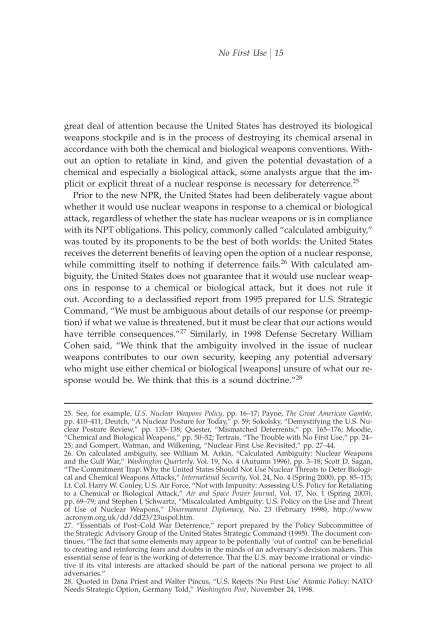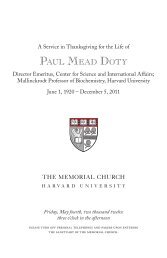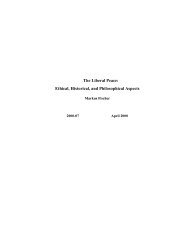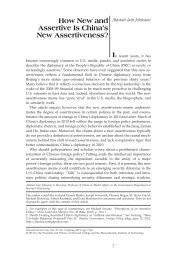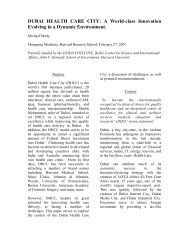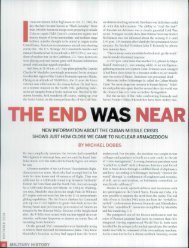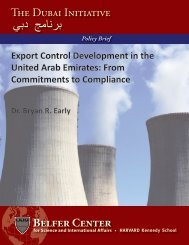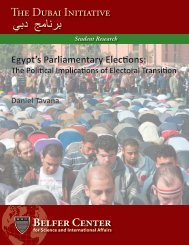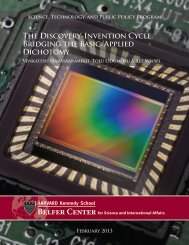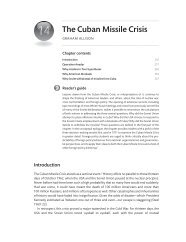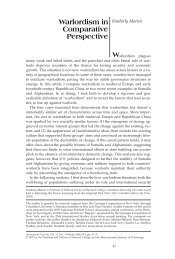The Next Step for U.S. Nuclear Policy - Project MUSE
The Next Step for U.S. Nuclear Policy - Project MUSE
The Next Step for U.S. Nuclear Policy - Project MUSE
Create successful ePaper yourself
Turn your PDF publications into a flip-book with our unique Google optimized e-Paper software.
No First Use 15<br />
great deal of attention because the United States has destroyed its biological<br />
weapons stockpile and is in the process of destroying its chemical arsenal in<br />
accordance with both the chemical and biological weapons conventions. Without<br />
an option to retaliate in kind, and given the potential devastation of a<br />
chemical and especially a biological attack, some analysts argue that the implicit<br />
or explicit threat of a nuclear response is necessary <strong>for</strong> deterrence. 25<br />
Prior to the new NPR, the United States had been deliberately vague about<br />
whether it would use nuclear weapons in response to a chemical or biological<br />
attack, regardless of whether the state has nuclear weapons or is in compliance<br />
with its NPT obligations. This policy, commonly called “calculated ambiguity,”<br />
was touted by its proponents to be the best of both worlds: the United States<br />
receives the deterrent beneªts of leaving open the option of a nuclear response,<br />
while committing itself to nothing if deterrence fails. 26 With calculated ambiguity,<br />
the United States does not guarantee that it would use nuclear weapons<br />
in response to a chemical or biological attack, but it does not rule it<br />
out. According to a declassiªed report from 1995 prepared <strong>for</strong> U.S. Strategic<br />
Command, “We must be ambiguous about details of our response (or preemption)<br />
if what we value is threatened, but it must be clear that our actions would<br />
have terrible consequences.” 27 Similarly, in 1998 Defense Secretary William<br />
Cohen said, “We think that the ambiguity involved in the issue of nuclear<br />
weapons contributes to our own security, keeping any potential adversary<br />
who might use either chemical or biological [weapons] unsure of what our response<br />
would be. We think that this is a sound doctrine.” 28<br />
25. See, <strong>for</strong> example, U.S. <strong>Nuclear</strong> Weapons <strong>Policy</strong>, pp. 16–17; Payne, <strong>The</strong> Great American Gamble,<br />
pp. 410–411; Deutch, “A <strong>Nuclear</strong> Posture <strong>for</strong> Today,” p. 59; Sokolsky, “Demystifying the U.S. <strong>Nuclear</strong><br />
Posture Review,” pp. 135–138; Quester, “Mismatched Deterrents,” pp. 165–176; Moodie,<br />
“Chemical and Biological Weapons,” pp. 50–52; Tertrais, “<strong>The</strong> Trouble with No First Use,” pp. 24–<br />
25; and Gompert, Watman, and Wilkening, “<strong>Nuclear</strong> First Use Revisited,” pp. 27–44.<br />
26. On calculated ambiguity, see William M. Arkin, “Calculated Ambiguity: <strong>Nuclear</strong> Weapons<br />
and the Gulf War,” Washington Quarterly, Vol. 19, No. 4 (Autumn 1996), pp. 3–18; Scott D. Sagan,<br />
“<strong>The</strong> Commitment Trap: Why the United States Should Not Use <strong>Nuclear</strong> Threats to Deter Biological<br />
and Chemical Weapons Attacks,” International Security, Vol. 24, No. 4 (Spring 2000), pp. 85–115;<br />
Lt. Col. Harry W. Conley, U.S. Air Force, “Not with Impunity: Assessing U.S. <strong>Policy</strong> <strong>for</strong> Retaliating<br />
to a Chemical or Biological Attack,” Air and Space Power Journal, Vol. 17, No. 1 (Spring 2003),<br />
pp. 69–79; and <strong>Step</strong>hen I. Schwartz, “Miscalculated Ambiguity: U.S. <strong>Policy</strong> on the Use and Threat<br />
of Use of <strong>Nuclear</strong> Weapons,” Disarmament Diplomacy, No. 23 (February 1998), http://www<br />
.acronym.org.uk/dd/dd23/23uspol.htm.<br />
27. “Essentials of Post–Cold War Deterrence,” report prepared by the <strong>Policy</strong> Subcommittee of<br />
the Strategic Advisory Group of the United States Strategic Command (1995). <strong>The</strong> document continues,<br />
“<strong>The</strong> fact that some elements may appear to be potentially ‘out of control’ can be beneªcial<br />
to creating and rein<strong>for</strong>cing fears and doubts in the minds of an adversary’s decision makers. This<br />
essential sense of fear is the working of deterrence. That the U.S. may become irrational or vindictive<br />
if its vital interests are attacked should be part of the national persona we project to all<br />
adversaries.”<br />
28. Quoted in Dana Priest and Walter Pincus, “U.S. Rejects ‘No First Use’ Atomic <strong>Policy</strong>: NATO<br />
Needs Strategic Option, Germany Told,” Washington Post, November 24, 1998.


